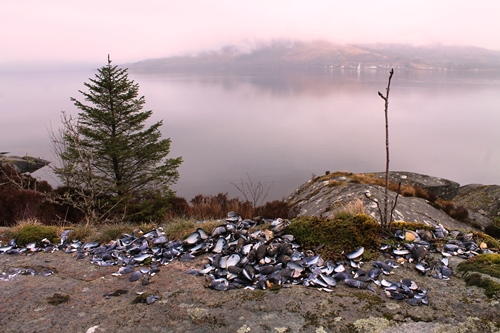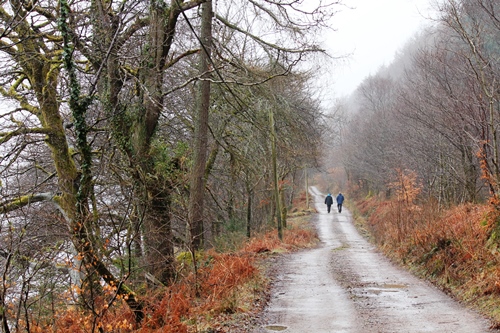At the entrance to the village a sign warns us of free-running dogs and wild chickens. Not being a fan of either, I proceed with caution down the muddy track to the collection of cottages around an open green that makes up the tiny settlement of Kenmore on the banks of Loch Fyne. The green space between the cottages was no accident, it was the place to dry the fishing nets in this village that long made its living from the produce pulled from the loch.
We follow the path down the side of the green (no sign of the dogs) until we reach a stone beach and a rocky promentory. The cloud is low, hiding the surrounding hills. The water is flat calm, glassy. A grey heron flies by with long, beating flaps of its wings. Down on the shore oystercatchers pick their way over the stones. At the top of the rocks the shells of their catch lay battered and smashed, a crunchy confetti. A twin-sailed boat makes slow progress down the loch. Not far away a group of divers, heads and bodies encased in black, slip over the side of their motor dinghy.
At the top of the rocks a memorial looks down across the loch and back towards the cottages of Kenmore. I scribble down the inscription in my notebook:
EVAN MACCOLL
THE LOCH FYNE BARD
BORN AT KENMORE 21st SEPT 1808
DIED AT TORONTO 24th JULY 1898
A long life and a long way from home. Later I will look up this poet, who was born on the banks of Loch Fyne to a father who was known across the region for having the most detailed knowledge of Celtic song and legend of many man in the area, whilst his mother was fond of local folklore and fairytales. MacColl’s father, concerned at the quality of education in the local school, hired a tutor. With this background, his poetry flourished. He would later move to Liverpool and then on to Kingston, Ontario. Despite being on the other side of the ocean, the memory of the landscape and the people he had left behind, and tales and songs told him by his parents, continued to shape his work throughout his life.
There are more tales to be discovered in Kenmore, although not whilst we are there. We clamber down from the rocks and the memorial and head back out of the river and down the forest track to our own cottage a few miles to the north. There I will sit with a view of the loch back down to Kenmore and see the divers motor past, their activities done for the day, and I will read of another famous child of the village. Belle MacPhedran was the only woman of Kenmore not to flee when the fishing boats returned not laden with a catch but an outbreak of cholera that had spread amongst the crews. She placed the men in an encampment outside the village and nursed some of them back to health, and soon would have her own collection of songs and stories about this Florence Nightingale of Loch Fyne.
The cholera outbreak at Kenmore happened in 1848-9, around the time Evan MacColl left Liverpool for Canada and a new life on the other side of the ocean. I wonder if he heard the story of Belle and what had happened in his home village. Whether he did or not, one thing is certain… in his poems and song he never forgot the place he had left behind:
Though thy green banks I no more may see,
While life’s warm stream in my bosom floweth
I’ll cease not lauding and loving thee.
Words: Paul Scraton
Pictures: Katrin Schönig
I have written an essay featuring more stories from the shore of Loch Fyne in the first edition of Elsewhere: A Journal of Place, to be published on 12 June 2015. You can find out more, and order a copy, here.








Beautiful. Lovely memories of time spent in a gorgeous place together. XX